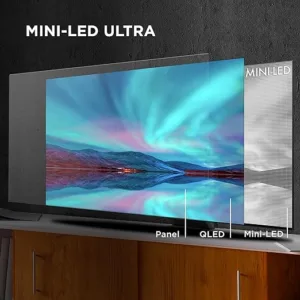Lets stop talking about MicroLED and OLED , and next gen display technology. They need work. Let’s talk about fairy dust and sparkles and magic or quantum dots as some nerds choose to call them.
I caught this article which lead me to this article which is how I got to this page right here. The first article is great, a huge discount on TCLs QLED TV, an 85-inch one that will satisfy everyone who buys it for what it is except the guys at the second article who are probably more precise than any consumer will every be, and they still have the wrong price for the TV at the bottom of the page which makes it even less likely that the review will impact an actual buyer.

This has nothing to do with the two articles. They do job perfectly for their intended audience. They just have little relevance to the mass consumption of TVs, and TVs are mass consumption products. They are not, and have never been, for connoisseurs.
Ay, there’s the rub. TVs are for normal people who think housewives with time and money on their hands make for excellent drama. Normal people don’t watch sporting events in groups, they glance at them, while figuring out where they put their last beer bottle, or trying to reach for a snack, or generally talking to the. people around them.
You find me someone who has spent more than $3,000 on a TV set and I will show you someone who cannot tell you the last time they actually watched a show on there. They may see the odd movie, and they are probably one of the olds and stuck on binge watching some reminder of their youth thirty or forty years ago, the quality of which will be suspect because, well, most digital transfers of old movies and TV shows are. It’s the economics of digitization of back catalogues. Its getting better, but a streaming version of The Godfather is not anywhere close to the experience of watching it on a screen, no matter how much you paid for your screen.
I suppose if you are old and well-monied enough to afford a $3,000 screen you probably have the eyesight for it, too, meaning, meh, you see what you see.
I wonder if that ageist or just a demographically sound analysis of premium TV audiences?
So, pixie dust quantum dots, when judiciously sprinkled on MiniLED devices will give you good enough, nay, great enough, TV viewing pleasure at a price that the norms can appreciate. TCL’s $1,600 85-inch QLED TV is not cheap – closer to the top of the range for all off us norms – but it’s worth the squeeze.
So, I ask myself why the TV makers at Samsung, LG, and Sony can’t make TVs that are worth the squeeze for the norms knowing that they can probably eke out a 10-15% premium over Hisense and TCL, and completely shut them out of the market?
I kind of know the answer to that – there’s a lot more that goes into those decisions and the commitments made years ago to pursuing OLED, WOLED, QD-OLED, etc. all have repercussions today. You can’t just walk away from that.
Nope, you can’t. But, by the time you see your numbers on OLED TVs drop down to find the norm demographic, TCL and Hisense are going to be right there with their OLED TVs and they will have a base of norms who are fine with choices they made years ago, and are willing to forego the premiums for Samsung, LG, and Sony.
And, if that isn’t enough to convince you that the TV market is not where it should be, you have to factor in the fact that the aging demographics of the future will have grown up watching TV on smartphones and laptops, and will be fine without a big screen TV. They will probably not want to spend four hours watching a football game or any other sport for that matter.
And if the streaming apps decide to go low and Apple never makes another Ridley Scott’s Napoleon, or Netflix finally realizes that the Zack Snyder universe has seen better days, it will be cheap content, cheap TVs all the way to the bank.
Quantum dots really are pixie dust. They give us norms a shot at the glory of brightness and vivid color and all the other good stuff promised by future generations of display technology but without the expectation that we will have to sell a kidney to get there.
I imagine most display engineers do not really want to think about using pixie dust and would prefer a more arduous and challenging approach to next generation television displays, but read between the lines of the market and you will find the TV market has not matured, but it is going through a fundamental transformation that was delayed or distorted by the pandemic.
We got excited about quarantined masses gorging on TV content. Yeah, there wasn’t much else to do for a couple of years. Now, there’s a lot more to do, and there’s a lot less money. And even if the heavens open up and cash falls from the sky on the norms, TV is not going to be the priority. All the data on viewing habits show fragmentation, an almost ADHD wave of viewing patterns across multiple devices.
What the heck is a premium TV when faced with all that?

